Co-design Session #3: Thresholds
Update October 24, 2018: The Co-design Session #3 Synthesis Report is now available.
The last of three co-design sessions was held on September 5th and 6th at the Inclusive Design Research Centre (IDRC) at 49 McCaul Street. The event was split between two evening sessions. The purpose of having an evening session was to accommodate participants who might be unable to attend during regular business hours. An audio describer was present at both nights and provided audio description of any visual material or built object as requested by participants.
Each day began at 5:15 pm and ended around 9 pm. Five IDRC members and one accessibility consultant from Sidewalk Labs facilitated a group of twenty people from the Greater Toronto Area participating in this collaborative event. The focus of the third, and last, session was on thresholds. Thus, the planned activities for the day encouraged participants to reflect on their personal experiences in moving between different spaces and environments and think about how to improve these transition points in the future. To discuss and come up with ideas related to different types of thresholds, we focused on the following areas:
- In & out: moving in and out of spaces
- Up & down: moving between different levels of a space
- Getting around: transitioning between different modes of transportation
Warm-Up Activity: Build a Door
Objective: encourage collaboration and creative thinking, familiarize participants with each other
Duration: 15-20 minutes
The first day began with a warm up activity. In this activity, participants were given the following imaginary scenario, “Imagine all doors disappeared from the world”. Then, each participant was given two random items written and embossed on a piece of paper. These items were purposely chosen to have varying levels of practical use for building doors, and included items such as “marshmallows”, “hedgehogs”, “foam blocks” and “bricks”. Participants were then asked to form groups of three and discuss ways to build a door with their materials. After about five minutes of brainstorming, two groups of three merged to create an even better door with the new materials. Groups had another five minutes to combine their ideas and build a better door. At the end of this activity, groups had a chance to share their ideas with the larger group. Facilitators encouraged groups to have fun with the activity, and not worry about developing a polished idea.

Introducing the themes for the session:
After the warm-up activity, the following themes were introduced to the audience. Each participant was assigned to a group to work on one of these themes for the rest of the session.
- In & Out: Moving between spaces
"This theme explores thresholds that we encounter moving in and out of spaces, for example moving in and out of buildings, private or public spaces or places with open or restricted access. We want you to think of your personal experiences transitioning between spaces. How do you think these thresholds limit or enable your urban experience?"
- Up & Down: Moving between different levels of a space
"This theme explores thresholds that exist between different levels of a space for example going from one level of a building to another. With this theme we want you to think of the different types of thresholds that are encountered moving up and down, and the challenges that exist in crossing these thresholds. How can these transitions be made more seamless?"
- Getting Around: Transitioning between different modes of transportation
"In urban settings, we often rely on different modes of transportation to get around the city. For example our morning commutes to work may include taking the subway, then switching and hopping on a street car and then walking to our work building. During these commutes we come across many thresholds that either slow us down or facilitate our journey to work. With this theme, we want you to think about your journey throughout the city, the thresholds you encounter, and reflect on your unique experience crossing these thresholds."
Design Activity: Part 1 - Group Discussion
Objective: Discussing each theme based on personal experiences
Duration: 45 minutes
Step one, two, and three of the design activity included questions that encouraged participants to reflect on their personal experiences and share their perspectives to build a common understanding of their theme.
Below are the questions asked in step one to three for each theme:
In & Out:
- As a group discuss and list what thresholds you encounter when entering or exiting buildings: (E.g. transitioning between indoor/outdoor, public/private, open/restricted access)
- As a group think about the negative experiences you have had transitioning in and out of spaces: (Times you felt confused, had to ask for help, denied access, etc.)
- As a group think about the positive experiences you have had transitioning in and out of spaces: (Times you felt informed, supported, allowed entry etc.)
Up & Down:
- As a group discuss and list what thresholds you have encountered when trying to move between different levels (different heights, raised platforms, floors, etc.): (E.g. inside buildings, in outdoor spaces, etc.)
- As a group think about the negative experiences you have had when moving between different levels: (Times you felt confused, had to ask for help, denied access, etc.)
- As a group think about the positive experiences you have had transitioning in and out of spaces: (Times you felt informed, supported, allowed entry etc.)
Getting Around:
- As a group discuss and list what thresholds you have encountered when traveling to different places in the city: (E.g. transitioning between walking, rolling, biking, driving, street car, etc.)
- As a group think about the negative experiences you have had moving between different modes of transportation: (Times you felt frustrated, in danger, rushed, etc.)
- As a group think about the positive experiences you have had moving between different modes of transportation: (Times you felt calm, safe, at ease, etc.)
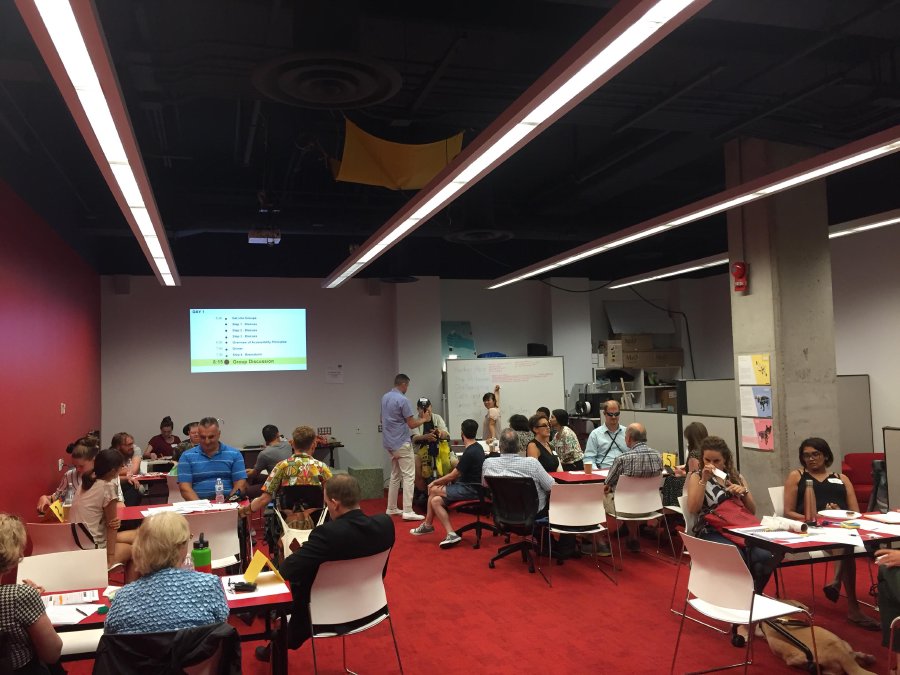
Design Activity: Overview of Sidewalk Accessibility Principles
Objective: Introduce the accessibility principles developed by Sidewalk Labs, and provide an opportunity for the group to review the principles and provide their input.
Duration: 20 minutes
A Sidewalk representative provided an overview of the accessibility principles developed by Sidewalk Labs. The principles were grouped into three main areas; digital, physical and general accessibility. Printed copies of the principles and examples were provided to each group for review.
Design Activity: Part 2 - Brainstorming
Objective: Brainstorming ideas
Duration: 30 minutes
After sharing personal experiences relevant to the theme assigned to their group and also learning about the accessibility principles, each group was given a challenge related to their theme to resolve. Groups had 30 minutes to brainstorm a pool of ideas to address their challenge. The challenges for each theme are presented below:
In & Out:
- Challenge: Imagine a better experience in the future for moving in and out of an office building
Up & Down:
- Challenge: Imagine a better experience in the future for moving between different levels
Getting Around:
- Challenge: Imagine a better experience in the future for switching modes of transportation
As the groups engaged in discussion, the assigned facilitators provided insight and guided the discussion to reflect on each theme. Each group then had the opportunity to briefly share their ideas with the larger group and received feedback before prototyping their idea the next day. The end of the group discussion on preliminary ideas marked the end of the first half of this two-day session. Participants were encouraged to reflect on their ideas and be more observant of the thresholds over the following day.
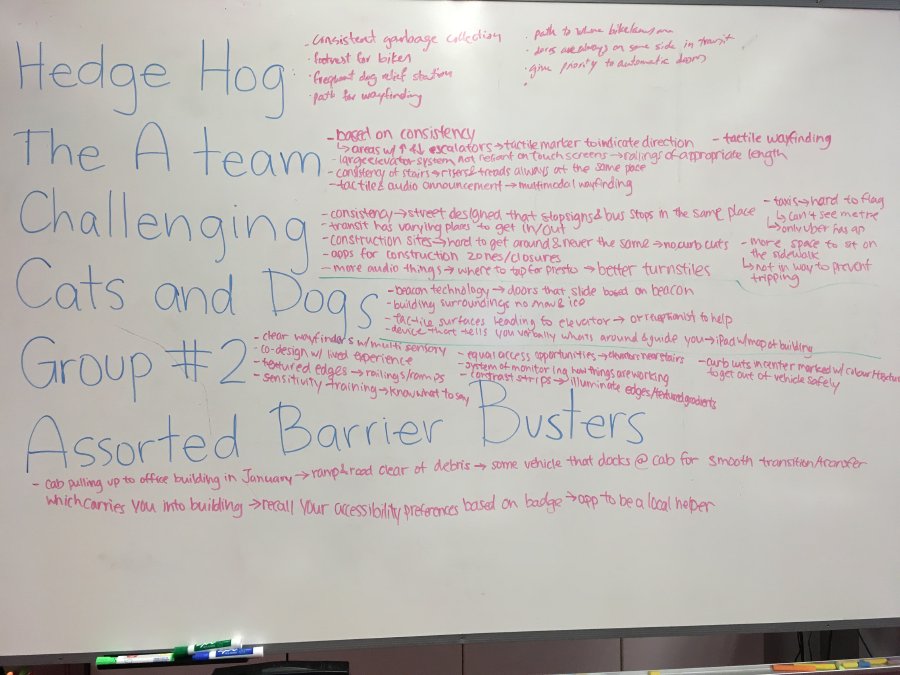
Image description for the group discussion whiteboard
DAY 2
Design Activity: Part 3 - Prototype Challenge
Objective: Building a prototype to meet unrepresented needs
Duration: 1 hour 30 minutes
The second day began promptly with the prototyping challenge. Participants were given an hour and a half to choose an idea they brainstormed the previous day, expand on the idea, and build or prepare a demonstration of their idea. Each group was provided some prompting questions to help this process: Is it accessible? Is it safe? Does it support independence? What would you need? How can technology help? Who else is involved?

Shown above is “Assorted Barrier Busters” group’s prototype. They have used lego blocks to build a platform, craft paper to build an elevator cube and plasticine to create a mobility device, such as an electric scooter and a guide dog.

Shown above is “Assorted Barrier Busters” group’s proposed “Access” app prototype made with craft paper. There is also a sheet of paper that shows the information they desire to include in their app, such as internal, external, thresholds, generic.
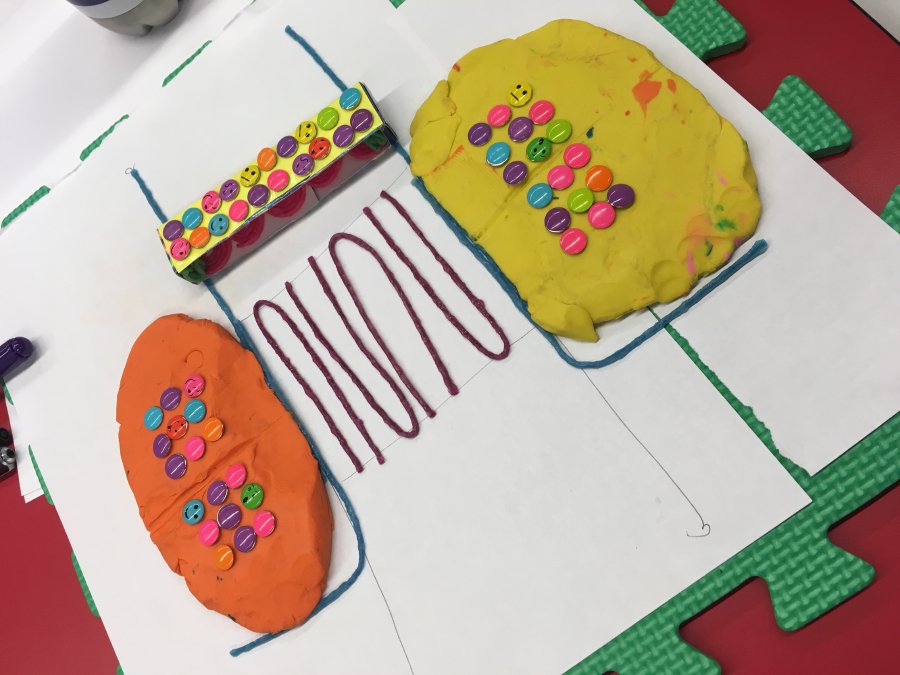
Shown above is “Challenging Hedgehog” group’s prototype made with plasticine to represent a special tile with the function of vibrating and heating the paver.
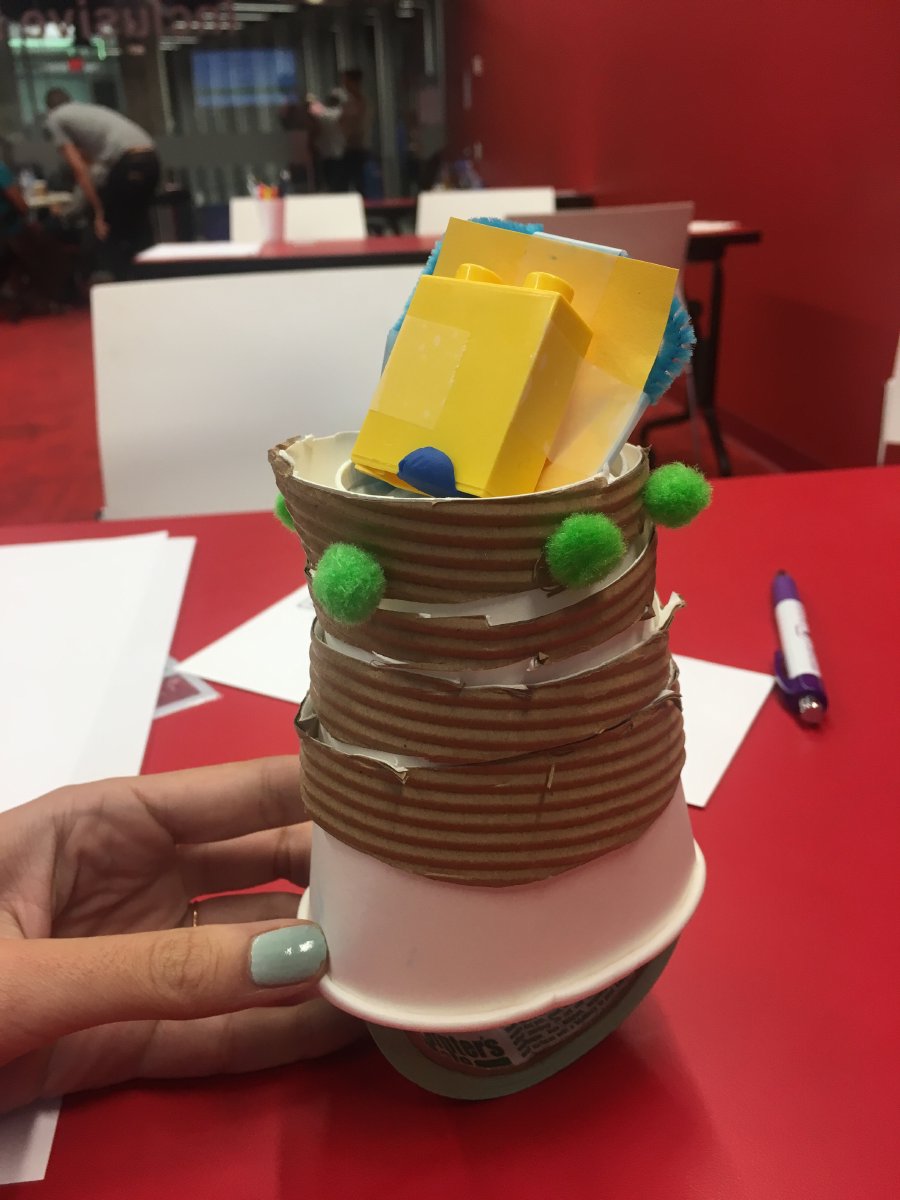
Shown above is “Cats & Dogs” group’s prototype made with paper cup, tape, lego block, and pipe cleaner and other craft material to represent a mini robot.
Design Activity: Part 4 - Swap and Critique prototype
Objective: Considering unrepresented needs
Duration: 30 minutes
After each group finished prototyping their selected ideas, time was provided for each group to quickly describe or demonstrate their idea. Then, each group swapped a written description of their idea accompanied by any built artifacts with another group, so the other group could critique their proposed solution using inclusion and accessibility questions provided below. Each group was provided with the following questions to reflect on their peer’s work:
- Who is excluded by this idea?
- What are the advantages of this idea?
- What are the disadvantages of this idea?
Once groups completed their critique, they returned the worksheets to the original groups. Each team then had half an hour to review the feedback they received and revise their prototype.
Final Group Discussion
For the last hour, each group shared their work with the rest of the teams in an open discussion. Teams were engaged in active discussion and questions when presenting each idea.
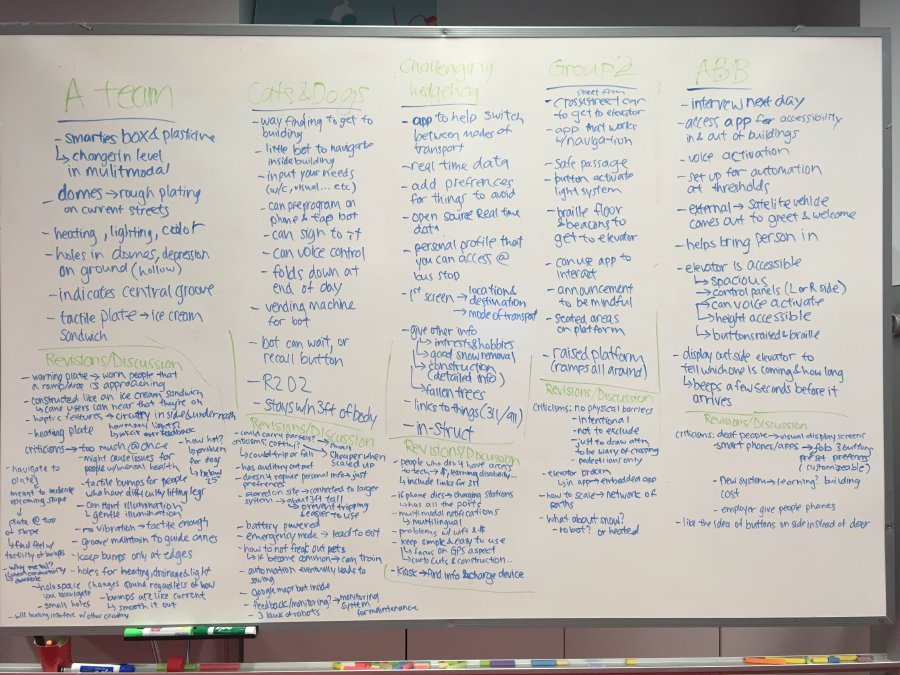
Image description for the prototype discussion whiteboard
At the end of the session, participants were asked to complete a feedback form in order to assess their experience through the day and inform IDRC how they can improve their future co-design sessions. The results from this session are available in the Co-design Session #3 Synthesis Report.
